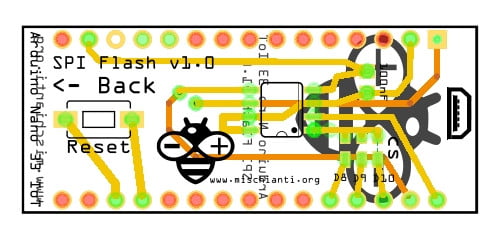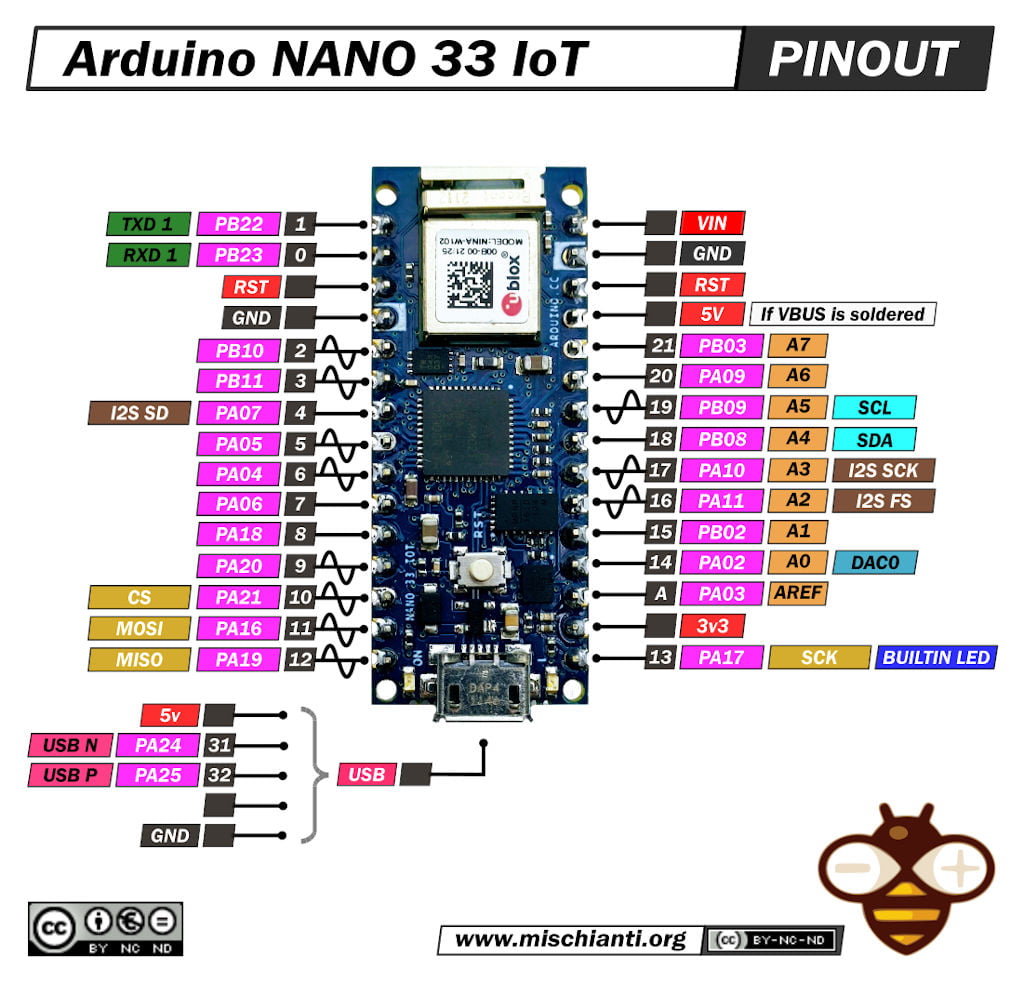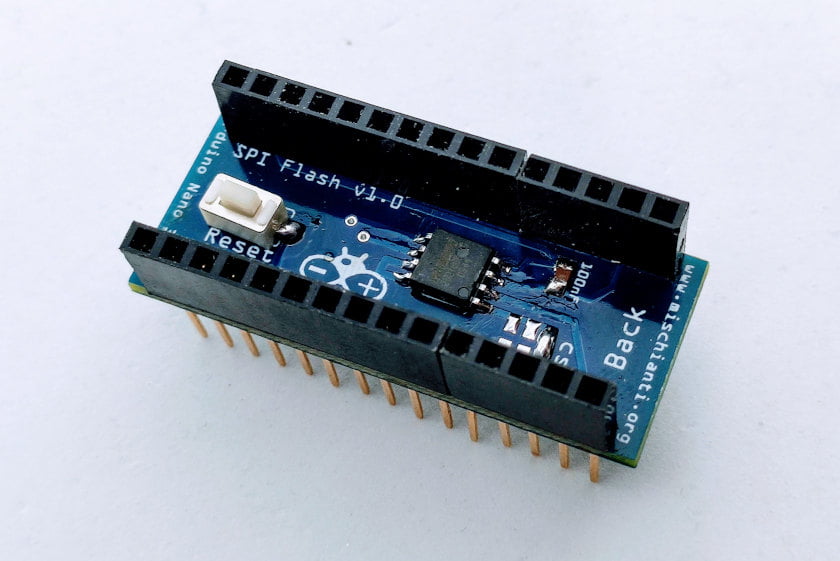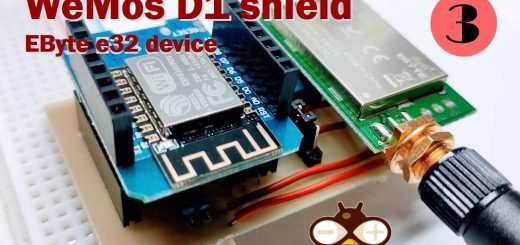Shield Arduino NANO 33 IoT per supporto memorie Flash SPI
Come l’Arduino MKR WiFi 1010, il NANO 33 IoT non ha memoria Flash per archiviare i dati. Ho scritto un articolo che spiega come interfacciare questi tipi di memoria, “Come utilizzare le memorie SPI Flash esterne“, e vorrei semplificare il processo di aggiunta di questi chip, quindi ho creato un altro semplice shield per aggiungere memoria Flash SPI esterni nel modo più veloce.
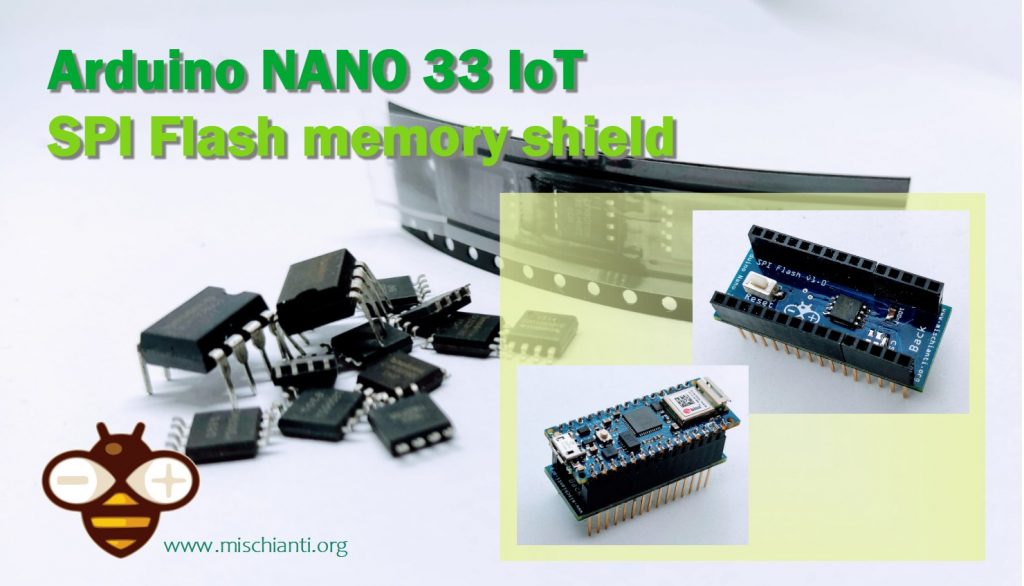
PCB
Ecco il PCB dello shield PCBWay

Il PCB è abbastanza semplice, ed ho aggiunto alcuni ponticelli da saldare per selezionare il pin CS.
La configurazione è la stessa degli esempi già pubblicati.
Prestare attenzione al pin CS selezionabile.
| Arduino | SPI Flash | |
|---|---|---|
| 10 | /CS | Pulled UP if not standard CS |
| 12 | DI (IO1) | |
| 11 | DI (IO0) | |
| 13 | CLK | |
| 3.3v | /WP | |
| 3.3v | /Hold | |
| GND | GND | |
| 3.3v | VCC |
Dall’alto, puoi vedere come appare lo shield.
Per il mio scopo, di solito utilizzo un chip w25q64 da 8 Mb Flash che è sufficiente per quasi tutto.
Ecco la mia selezione di memorie SPI Flash w25q16 SMD 2Mb - w25q16 Discrete 2Mb - w25q32 SMD 4Mb - w25q32 Discrete 4Mb - w25q64 SMD 8Mb - w25q64 Discrete 8Mb - w25q128 SMD 16Mb - w25q128 Discrete 16Mb W25Q32 W25Q64 w25q128 module 4Mb 8Mb 16Mb
Qui i bottoni SMD 3*6*2.5 SMD buttons 3X6X2.5
Condensatori SMD 805 0805 SMD Capacitor kit
Il risultato è molto utile e lo spazio utilizzato è limitato.
Sketch di esempio
Qui c’è un semplice esempio.
/*
* Use SPIFlash with FAT filesystem
* Write data inside a file
* Read data and info from the file
* Get the list of files in the directory
*
* library Adafruit_SPIFlash and SdFat - AdafruitFork
*
* by Mischianti Renzo <https://mischianti.org>
*
* https://mischianti.org/
*
* SPIFlash connected via SPI standard check wiring on the article
*
*/
#include "SdFat.h"
#include "Adafruit_SPIFlash.h"
Adafruit_FlashTransport_SPI flashTransport(SS, SPI); // Set CS and SPI interface
Adafruit_SPIFlash flash(&flashTransport);
// file system object from SdFat
FatFileSystem fatfs;
//The setup function is called once at startup of the sketch
void setup()
{
// Initialize serial port and wait for it to open before continuing.
Serial.begin(115200);
while (!Serial) {
delay(100);
}
Serial.println("Adafruit SPI Flash FatFs Full Usage Example");
// Initialize flash library and check its chip ID.
if (!flash.begin()) {
Serial.println("Error, failed to initialize flash chip!");
while(1) yield();
}
Serial.print("JEDEC ID: "); Serial.println(flash.getJEDECID(), HEX);
Serial.print("Flash size: "); Serial.println(flash.size());
Serial.flush();
// First call begin to mount the filesystem. Check that it returns true
// to make sure the filesystem was mounted.
if (!fatfs.begin(&flash)) {
Serial.println("Error, failed to mount newly formatted filesystem!");
Serial.println("Was the flash chip formatted with the SdFat_format example?");
while(1) yield();
}
Serial.println("Mounted filesystem!");
Serial.println();
// create directory mischianti if not exist
if (!fatfs.exists("/mischianti")) {
Serial.println("mischianti directory not found, creating...");
// Use mkdir to create directory (note you should _not_ have a trailing slash).
fatfs.mkdir("/mischianti");
if ( !fatfs.exists("/mischianti") ) {
Serial.println("Error, failed to create directory!");
while(1) yield();
}else {
Serial.println("Created directory!");
}
}
Serial.println();
// Create a file
File writeFile = fatfs.open("/test.txt", FILE_WRITE);
if (writeFile) {
Serial.println("Opened file /test.txt for writing/appending...");
// Once open for writing you can print to the file as if you're printing
// to the serial terminal, the same functions are available.
writeFile.println("www.mischianti.org");
writeFile.print("Write a number: "); writeFile.println(123, DEC);
writeFile.print("Write HEX number: 0x"); writeFile.println(123, HEX);
// Close the file when finished writing.
writeFile.close();
Serial.println("Wrote to file /test.txt!");
} else {
Serial.println("Error, failed to open test.txt for writing!");
while(1) yield();
}
Serial.println();
// Now open the same file but for reading.
File readFile = fatfs.open("/test.txt", FILE_READ);
if (readFile) {
// Read a line of data:
String line = readFile.readStringUntil('\n');
Serial.print("First line of test.txt: "); Serial.println(line);
// You can get the current position, remaining data, and total size of the file:
Serial.print("Total size of test.txt (bytes): "); Serial.println(readFile.size(), DEC);
Serial.print("Current position in test.txt: "); Serial.println(readFile.position(), DEC);
Serial.print("Available data to read in test.txt: "); Serial.println(readFile.available(), DEC);
char filename[64];
readFile.getName(filename, sizeof(filename));
Serial.print("File name: "); Serial.println(filename);
Serial.print("Is file a directory? "); Serial.println(readFile.isDirectory() ? "Yes" : "No");
} else {
Serial.println("Error, failed to open test.txt for reading!");
while(1) yield();
}
Serial.println();
// You can open a directory to list all the children (files and directories).
File testDir = fatfs.open("/");
if (testDir) {
if (!testDir.isDirectory()) {
Serial.println("Error, expected test to be a directory!");
while(1) yield();
}
Serial.println("Listing children of directory /:");
File child = testDir.openNextFile();
while (child) {
Serial.print(child.size()); Serial.print("bytes \t");
char filename[64];
child.getName(filename, sizeof(filename));
// Print the file name and mention if it's a directory.
Serial.print("- "); Serial.print(filename);
if (child.isDirectory()) {
Serial.print(" (directory)");
}
Serial.println();
// Keep calling openNextFile to get a new file.
child = testDir.openNextFile();
}
Serial.println();
Serial.println("All file in the directory writed");
} else {
Serial.println("Error, failed to open test directory!");
while(1) yield();
}
}
// The loop function is called in an endless loop
void loop()
{
}
Ed ecco l’uscita seriale.
Connetti alla porta seriale COM19 a 115200
Adafruit SPI Flash FatFs Full Usage Example
JEDEC ID: EF4017
Flash size: 8388608
Mounted filesystem!
mischianti directory not found, creating...
Created directory!
Opened file /test.txt for writing/appending...
Wrote to file /test.txt!
First line of test.txt: www.mischianti.org
Total size of test.txt (bytes): 65
Current position in test.txt: 20
Available data to read in test.txt: 45
File name: test.txt
Is file a directory? No
Listing children of directory /:
0bytes - mischianti (directory)
65bytes - test.txt
All file in the directory writed
Grazie
- Arduino SAMD NINA: piedinatura, specifiche e configurazione Arduino IDE
- Arduino SAMD NINA: WiFiNINA, aggiornamento firmware e led RGB
- Arduino SAMD (NANO 33 e MKR): file system FAT su memoria flash SPI esterna
- i2c Arduino SAMD MKR: interfaccia aggiuntiva SERCOM, rete e scanner di indirizzi
- Arduino MKR SAMD: file system FAT su memoria flash SPI esterna
- Collegamento dell’EByte E70 ai dispositivi Arduino SAMD (Nano 33, MKR…) e un semplice sketch di esempio

